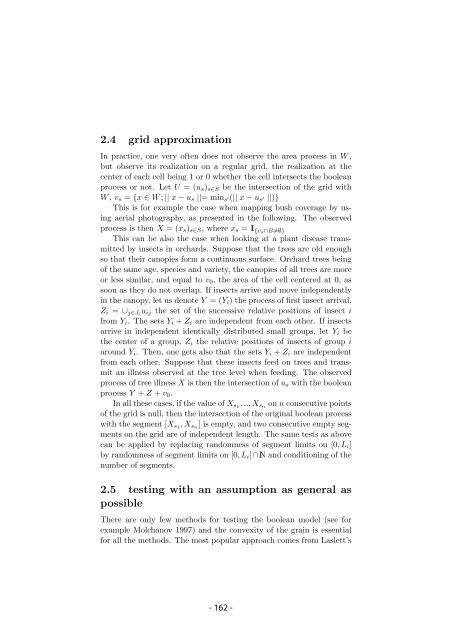Ecole Nationale Supérieure Agronomique de Montpellier ... - CIAM
Ecole Nationale Supérieure Agronomique de Montpellier ... - CIAM
Ecole Nationale Supérieure Agronomique de Montpellier ... - CIAM
You also want an ePaper? Increase the reach of your titles
YUMPU automatically turns print PDFs into web optimized ePapers that Google loves.
2.4 grid approximation<br />
In practice, one very often does not observe the area process in W ,<br />
but observe its realization on a regular grid, the realization at the<br />
center of each cell being 1 or 0 whether the cell intersects the boolean<br />
process or not. Let U = (us)s∈S be the intersection of the grid with<br />
W , vs = {x ∈ W ; || x − us ||= mins<br />
′(|| x − us ′ ||)}<br />
This is for example the case when mapping bush coverage by using<br />
aerial photography, as presented in the following. The observed<br />
process is then X = (xs)s∈S, where xs = 1I {vs∩B=∅}<br />
This can be also the case when looking at a plant disease transmitted<br />
by insects in orchards. Suppose that the trees are old enough<br />
so that their canopies form a continuous surface. Orchard trees being<br />
of the same age, species and variety, the canopies of all trees are more<br />
or less similar, and equal to v0, the area of the cell centered at 0, as<br />
soon as they do not overlap. If insects arrive and move in<strong>de</strong>pen<strong>de</strong>ntly<br />
in the canopy, let us <strong>de</strong>note Y = (Yi) the process of first insect arrival,<br />
Zi = ∪j∈Ji uij the set of the successive relative positions of insect i<br />
from Yi. The sets Yi + Zi are in<strong>de</strong>pen<strong>de</strong>nt from each other. If insects<br />
arrive in in<strong>de</strong>pen<strong>de</strong>nt i<strong>de</strong>ntically distributed small groups, let Yi be<br />
the center of a group, Zi the relative positions of insects of group i<br />
around Yi. Then, one gets also that the sets Yi + Zi are in<strong>de</strong>pen<strong>de</strong>nt<br />
from each other. Suppose that these insects feed on trees and transmit<br />
an illness observed at the tree level when feeding. The observed<br />
process of tree illness X is then the intersection of us with the boolean<br />
process Y + Z + v0.<br />
In all these cases, if the value of Xs1 , .., Xsn on n consecutive points<br />
of the grid is null, then the intersection of the original boolean process<br />
with the segment [Xs1 , Xsn] is empty, and two consecutive empty segments<br />
on the grid are of in<strong>de</strong>pen<strong>de</strong>nt length. The same tests as above<br />
can be applied by replacing randomness of segment limits on [0, Li]<br />
by randomness of segment limits on [0, Li]∩IN and conditioning of the<br />
number of segments.<br />
2.5 testing with an assumption as general as<br />
possible<br />
There are only few methods for testing the boolean mo<strong>de</strong>l (see for<br />
example Molchanov 1997) and the convexity of the grain is essential<br />
for all the methods. The most popular approach comes from Laslett’s



